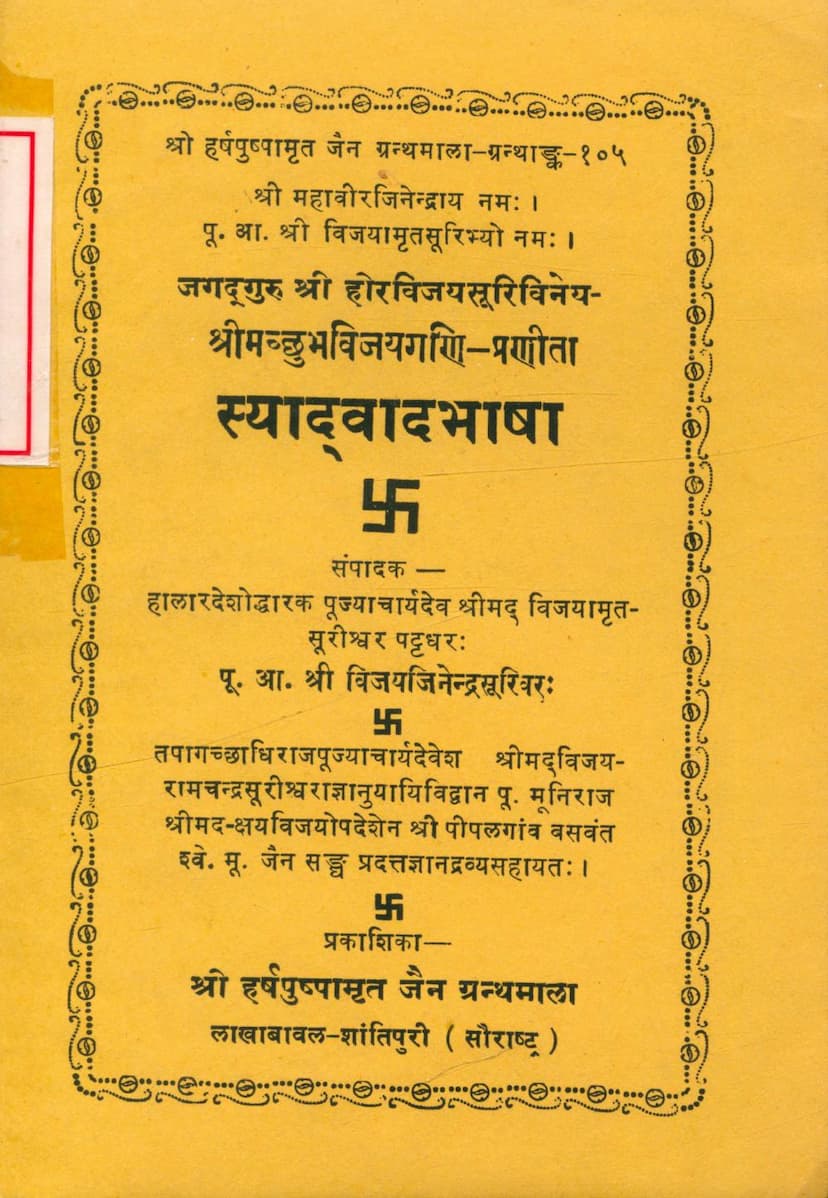Syadwad Bhasha
Added to library: September 2, 2025

Summary
This document is the introduction and initial chapters of a Jain text titled "Syadwad Bhasha" (स्यादवादभाषा), authored by Pandit Shubhavijay Gani and published by Shri Harshpushpamrut Jain Granthmala. The book is a commentary or elaboration on the principles of Syadvaada, a core doctrine of Jainism.
Here's a breakdown of the provided content:
Title and Authorship:
- Book Title: Syadwad Bhasha (स्यादवादभाषा)
- Author: Pandit Shubhavijay Gani (पण्डित श्रीशुभविजयगणि)
- Editor: Pujyacharya Shrimad Vijayjinendrasuri (पू. आ. श्री विजयजिनेन्द्रसूरिवरः)
- Publisher: Shri Harshpushpamrut Jain Granthmala (श्री हर्षपुष्पामृत जैन ग्रन्थमाला)
Introduction and Context:
- The book is presented as a simplified text for young learners to understand Syadvaada, a profound philosophical concept in Jainism, making its difficult subject matter more accessible.
- Pandit Shubhavijay Gani is described as a disciple of Jagadguru Hiravijayasuri and the compiler of "Senprashn" (प्रश्नारसमूच्चय).
- The text was originally written in Vikram Samvat 1667 (1610-1611 CE) and was first published by the Seth Devchand Lalbhai Pustakoddhar Fund in Vikram Samvat 1667.
- The current edition is a revised version.
- The publication was made possible with the financial assistance from the Shri Peepalgaon Basvant Shvetamber Mool Sangh.
Key Jain Philosophical Concepts Discussed (Early Chapters):
The core of the provided text delves into the fundamental epistemological and metaphysical principles of Jainism, particularly concerning knowledge (Pramana) and reality (Naya).
-
Pramana (Valid Knowledge):
- The text defines Pramana as "knowledge that knows itself and others" (स्वपरव्यवसायि ज्ञानं प्रमाणम्).
- It discusses the nature of knowledge, its scope, and its validity.
- It distinguishes between Pratyaksha (Direct Perception) and Paroksha (Indirect Perception).
- Pratyaksha is further divided into:
- Saavyavaharika (Empirical/Conventional): Knowledge gained through sensory organs (Indriyas) and the mind (Manas).
- Paramarthika (Absolute/Ultimate): Direct knowledge of the soul (Atma) through the destruction of obscuring karmas, like Avadhi, Manahparyaya, and Kevala Jnana.
- Paroksha includes:
- Smriti (Memory): Recollection of past experiences.
- Pratyabhigyaan (Recognition): Identifying something as the same as previously perceived.
- Tarka (Reasoning/Logic): Inferential knowledge based on cause and effect.
- Anumana (Inference): Drawing conclusions from observed evidence (e.g., smoke implies fire).
- Aagama (Testimony): Knowledge derived from reliable sources, like scriptures or trustworthy individuals (Apta).
- Pratyaksha is further divided into:
- Pramanaphal (Fruit of Knowledge): The result of valid knowledge is described as the removal of ignorance, followed by acceptance or rejection (Hano-padan-upeksha).
- Pramanabhasa (Fallacies of Knowledge): The text also outlines various forms of incorrect knowledge that mimic valid knowledge but are ultimately erroneous.
-
Naya (Standpoints/Perspectives):
- The text introduces the concept of Naya, which represents different ways of understanding reality.
- It categorizes Nayas into two main types:
- Dravyarthika Naya (Substantial/Essence Perspective): Focuses on the underlying substance or essence of things, disregarding superficial differences. It is further divided into Naigama, Sangraha, and Vyavahara.
- Paryayarthika Naya (Particular/Mode Perspective): Focuses on the specific modes, characteristics, and temporal aspects of things. It is divided into Rujusutra, Shabdama, Samabhirudha, and Evam-bhuta.
- The text elaborates on each of these Nayas, explaining their focus and providing examples. It also discusses their respective fallacious counterparts (Naya-abhasa).
-
The Soul (Jiva) and Other Realities (Ajeeva):
- The text provides detailed descriptions of the soul (Jiva) as an eternal, conscious entity, the doer (Karta), experiencer (Bhokta), and the controller of its own body.
- It discusses the soul's characteristics, its relationship with karma (Pudgala), and its states (Samsari and Mukta).
- It also elaborates on the nature of other Jain categories (Dravyas):
- Dharma (Medium of Motion): Responsible for facilitating movement.
- Adharma (Medium of Rest): Responsible for facilitating rest.
- Akasha (Space): Accommodates all substances.
- Kala (Time): Responsible for change and temporal sequence.
- Pudgala (Matter): Possesses properties like touch, taste, smell, and color, and can be gross or subtle.
- The text provides extensive arguments and examples to demonstrate the sentience (chetana) of seemingly inanimate substances like earth (Prithvi), water (Ap), fire (Tej), air (Vayu), and plants (Vanaspti), a key tenet of Jainism.
- It explains Karma as a form of matter that adheres to the soul, leading to bondage (Bandha) and influencing its experiences.
- Ashrava (Influx of Karma): Caused by passions (Kashaya) and activities of mind, speech, and body.
- Samvara (Cessation of Karma Influx): Achieved through controlling passions and activities.
- Nirjara (Shedding of Karma): The process of burning off accumulated karma through austerities.
- Moksha (Liberation): The ultimate goal of freeing the soul from all karmic bondage.
-
Vad (Debate/Discussion):
- The text introduces the concept of "Vad" as the process of discussing and establishing truths, involving arguments and counter-arguments to resolve opposing viewpoints.
- It differentiates between the Jigishu (one who wants to win) and the Tattva-nirninishu (one who wants to ascertain the truth) in a debate.
In essence, "Syadwad Bhasha" aims to systematically explain the Jain theory of knowledge (Pramana) and reality (Naya), the nature of the soul and other substances, and the path to liberation, all within the framework of the Syadvaada doctrine, which posits that all truths are conditional and relative to a particular standpoint. The provided excerpts cover the foundational elements of Jain epistemology and ontology.